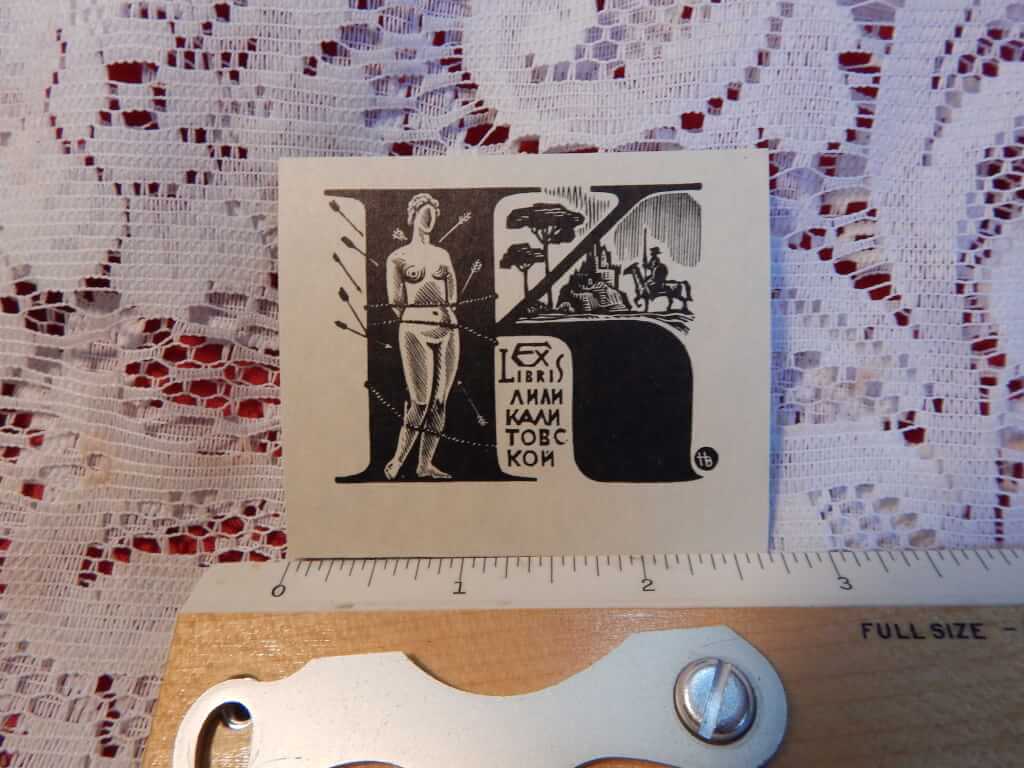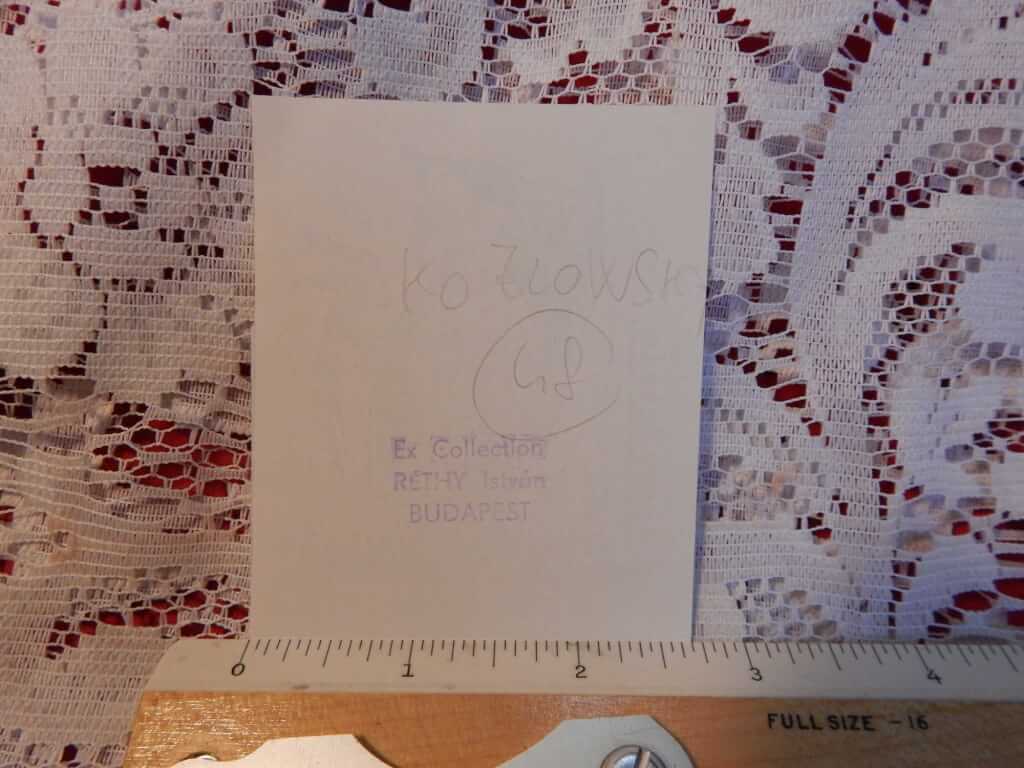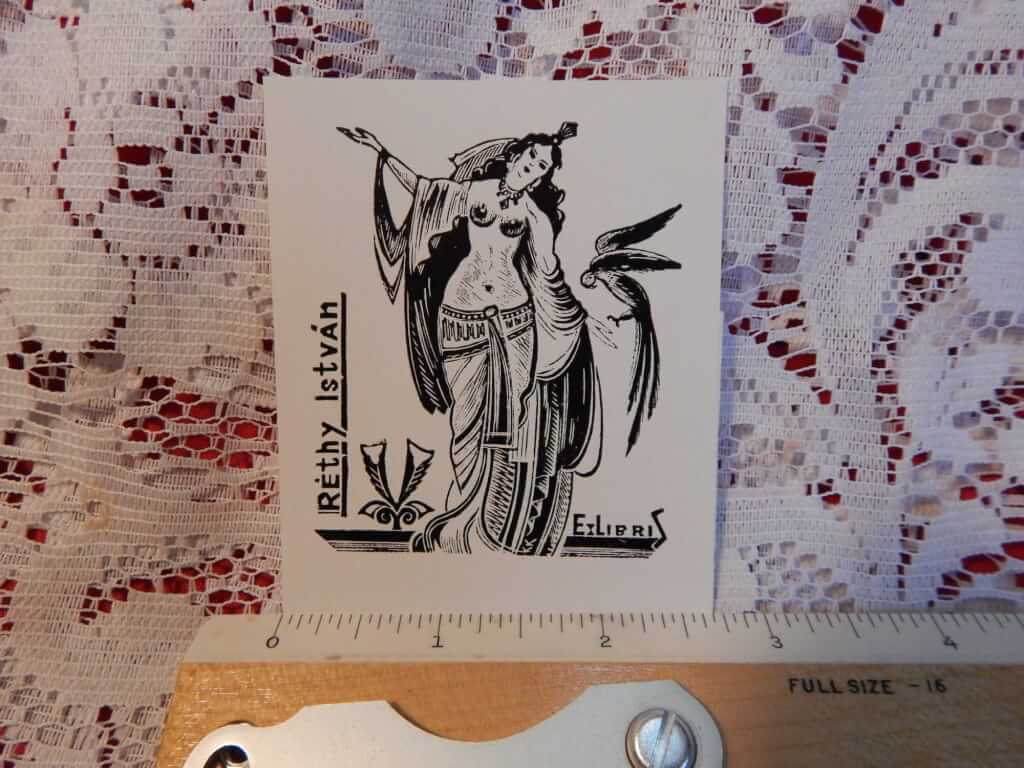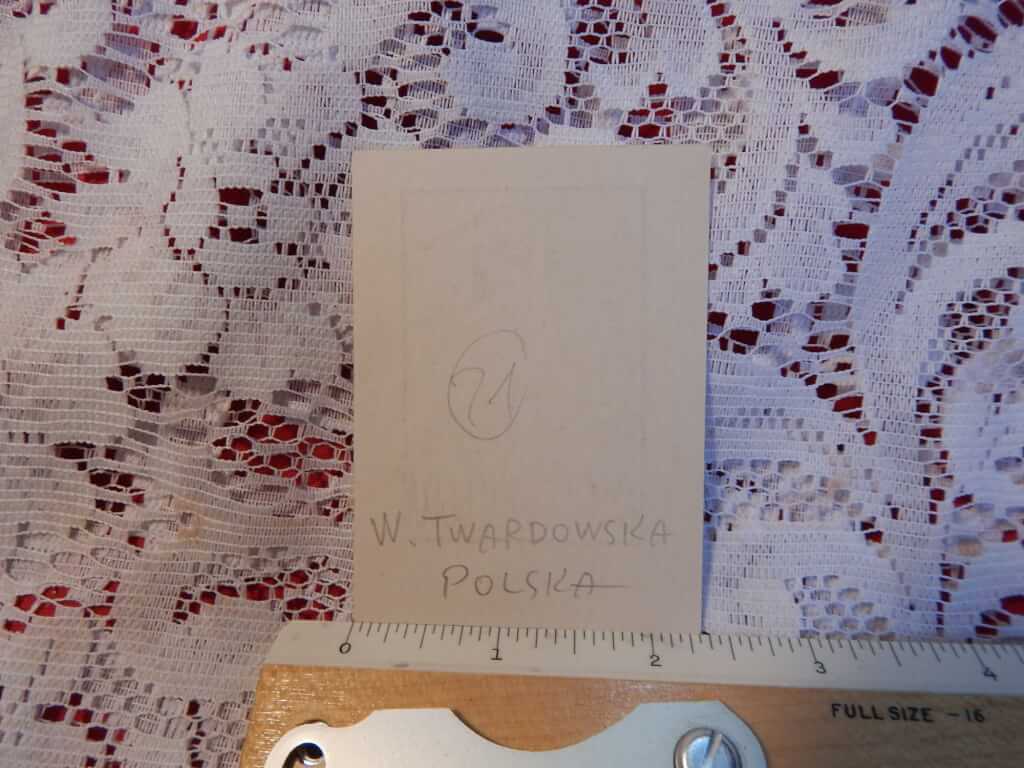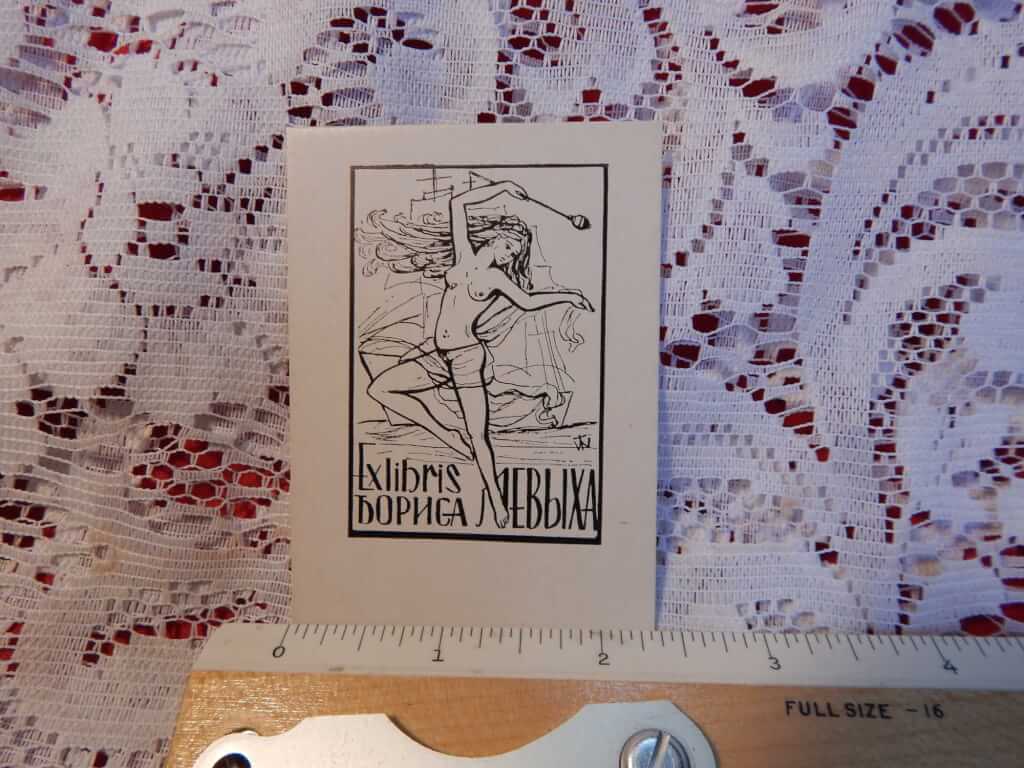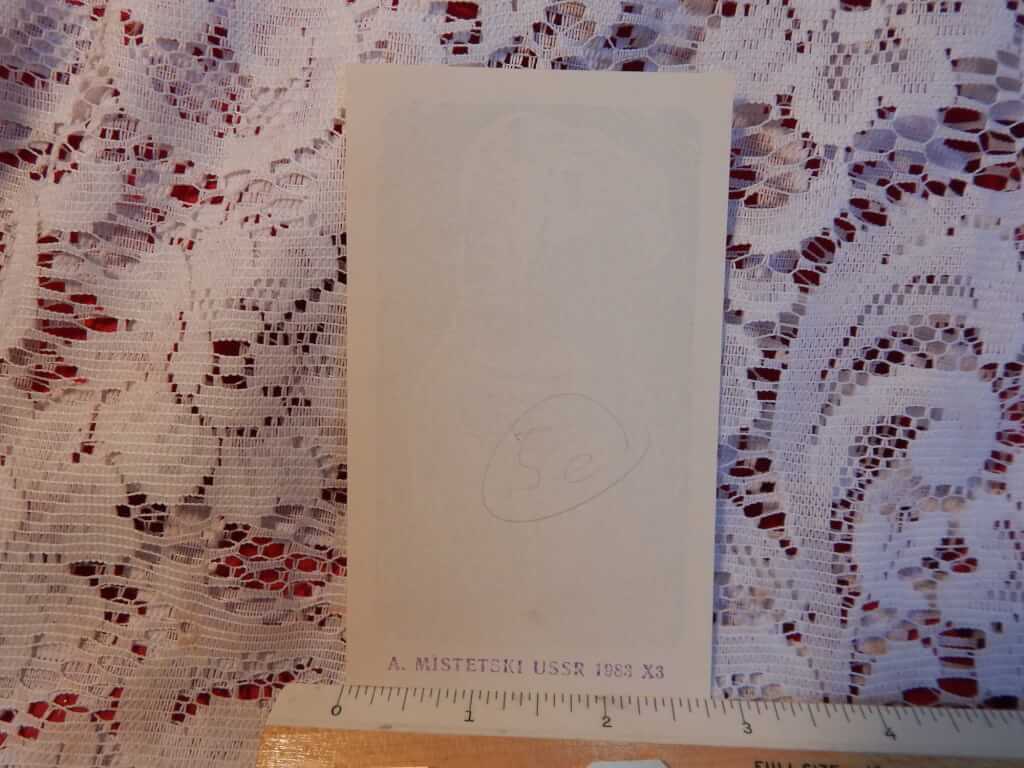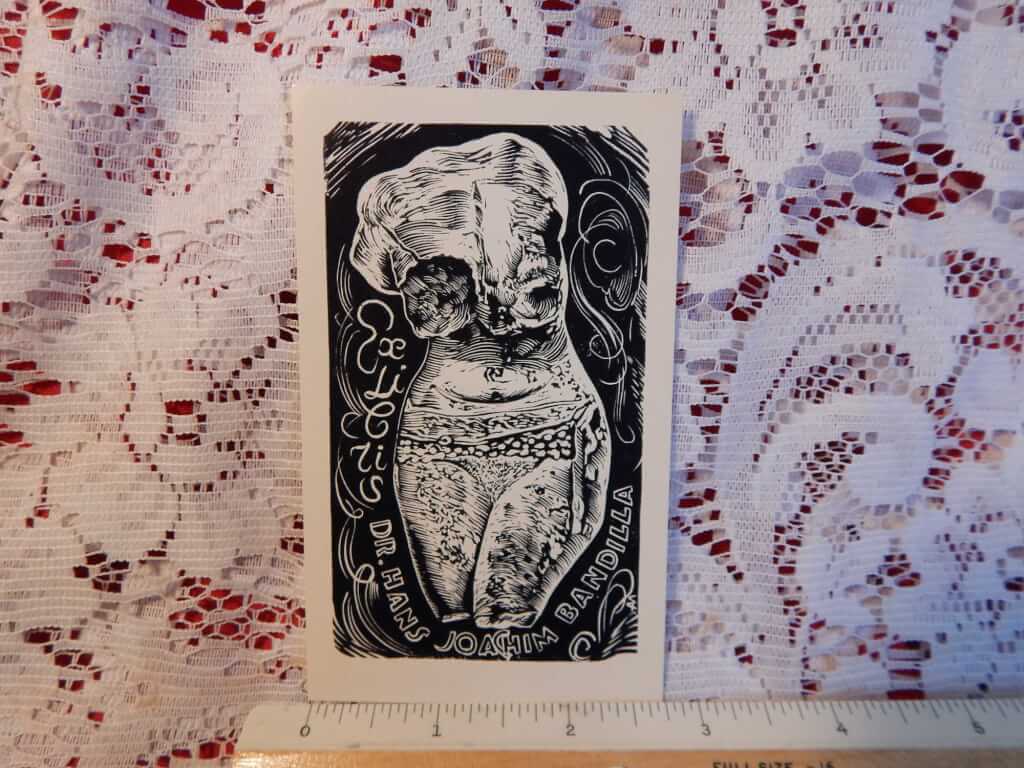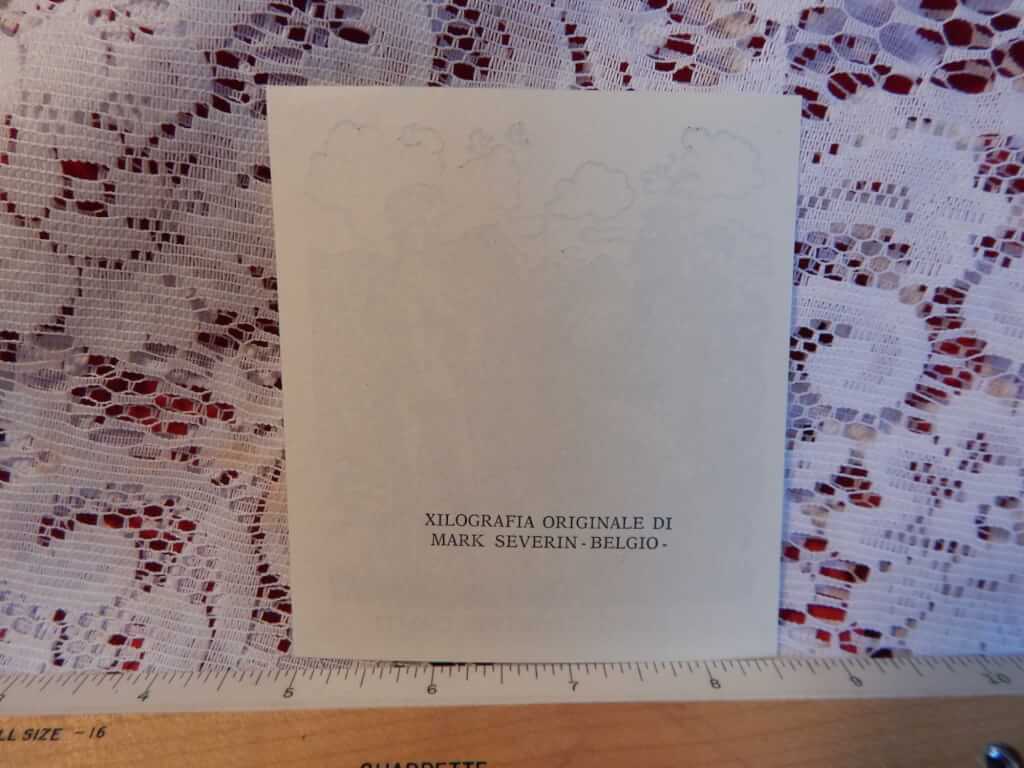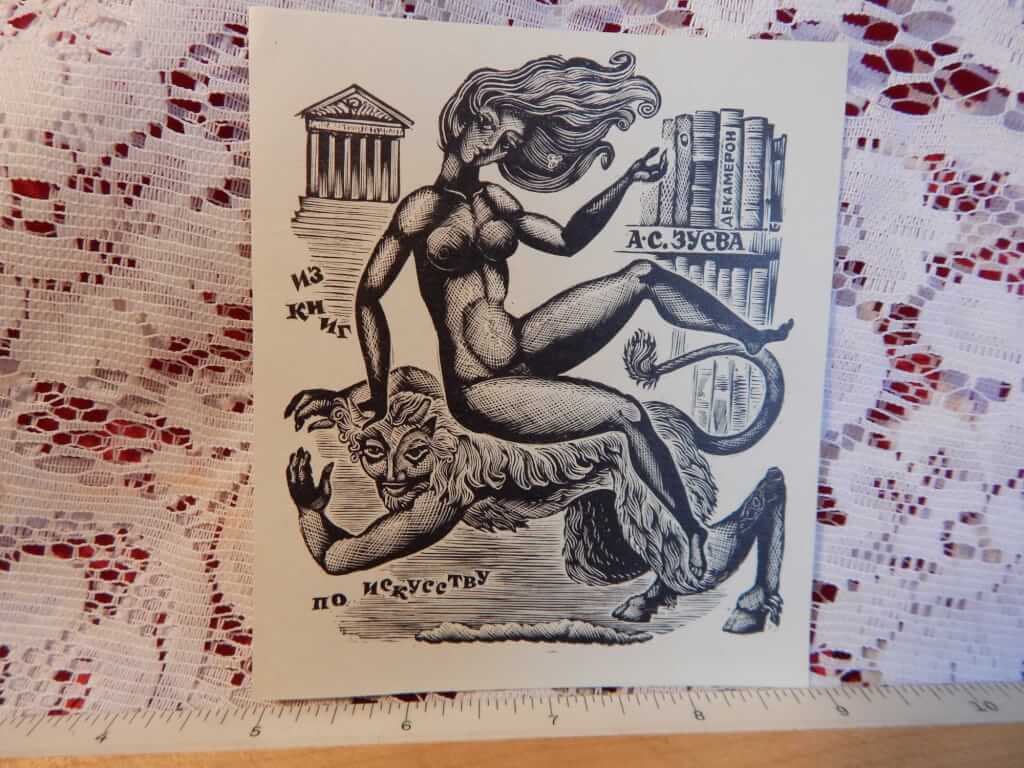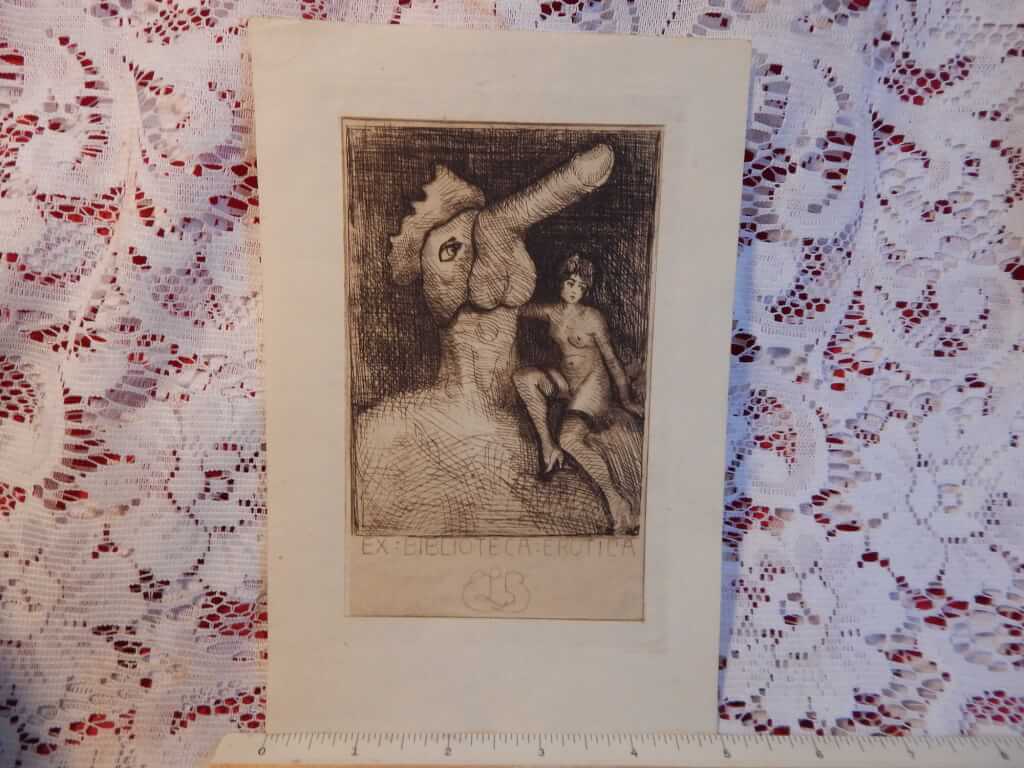-
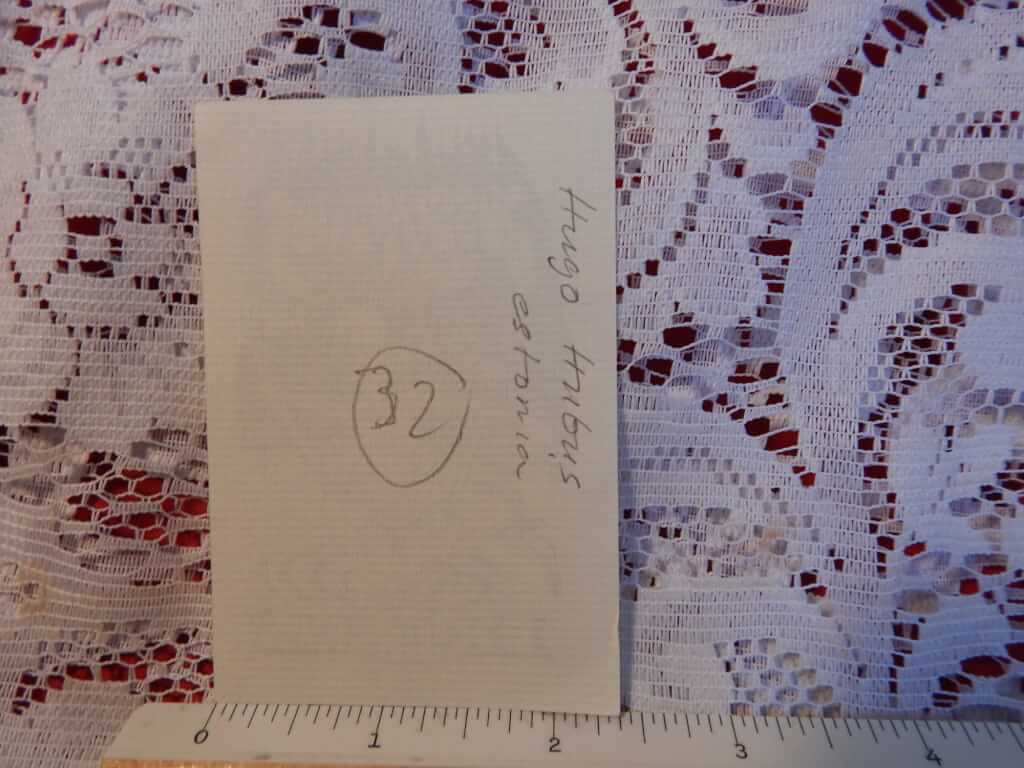
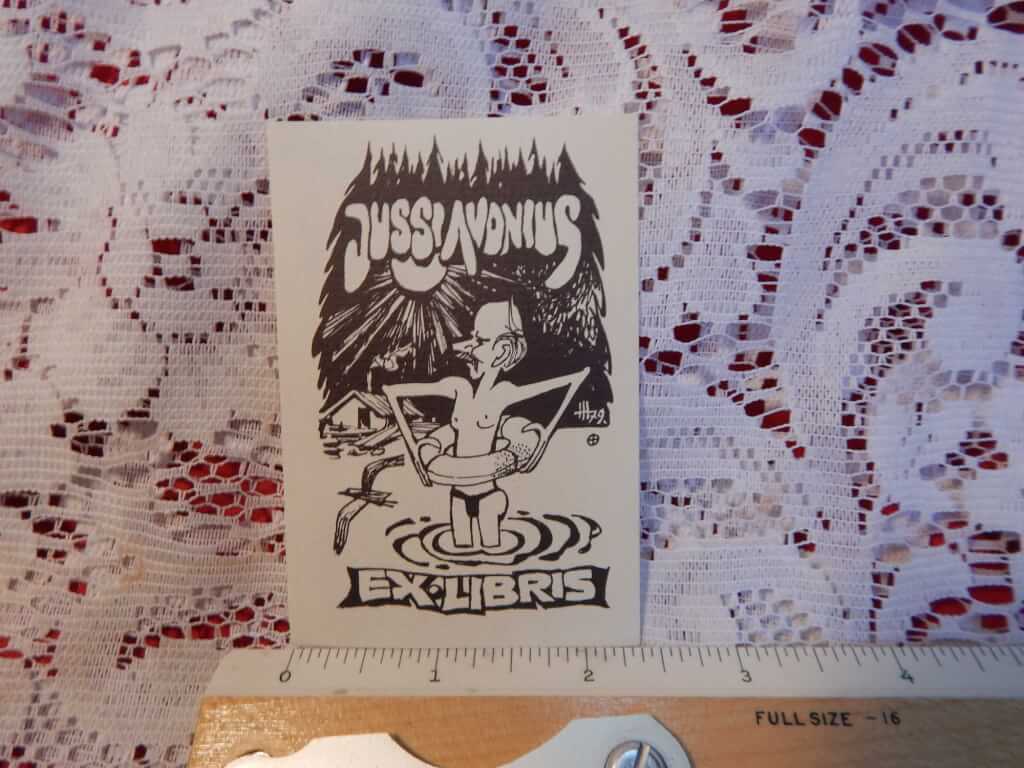 Ex Libris Jussi Avonius, by Hugo Hiibus purchased from a collection in Italy, "Hugo Hiibus | estonia" written on back in pencil Humourous man in knee deep water wearing an lifebuoy/life preserver. Hugo Hiibus (born in 1929) is a popular Estonian cartoonist and personality. He studied at the Estonian State Institute of the Arts, graduating in graphic art. From 1955-1957 he worked in the newspaper People's Voice, and in 1957-1959 in the journal Pikker as an artistic editor. In the years 1972-1984 he worked in the editorial office of the Kodumaa newspaper. He was a member of the ENSV Art Foundation (1961). His first cartoon appeared at the Institute in 1950. Hiibus has been an active exlibris and poster artist and a bookmaker. The cartoons of Hugo Hiibus have been published in almost all editions published in Estonia. Hiibas is both a member of the Estonian Artists' Union (1960) and a Journalist Association (1958). He is also a member of the Board of the Estonian Humor Union.
Ex Libris Jussi Avonius, by Hugo Hiibus purchased from a collection in Italy, "Hugo Hiibus | estonia" written on back in pencil Humourous man in knee deep water wearing an lifebuoy/life preserver. Hugo Hiibus (born in 1929) is a popular Estonian cartoonist and personality. He studied at the Estonian State Institute of the Arts, graduating in graphic art. From 1955-1957 he worked in the newspaper People's Voice, and in 1957-1959 in the journal Pikker as an artistic editor. In the years 1972-1984 he worked in the editorial office of the Kodumaa newspaper. He was a member of the ENSV Art Foundation (1961). His first cartoon appeared at the Institute in 1950. Hiibus has been an active exlibris and poster artist and a bookmaker. The cartoons of Hugo Hiibus have been published in almost all editions published in Estonia. Hiibas is both a member of the Estonian Artists' Union (1960) and a Journalist Association (1958). He is also a member of the Board of the Estonian Humor Union. -
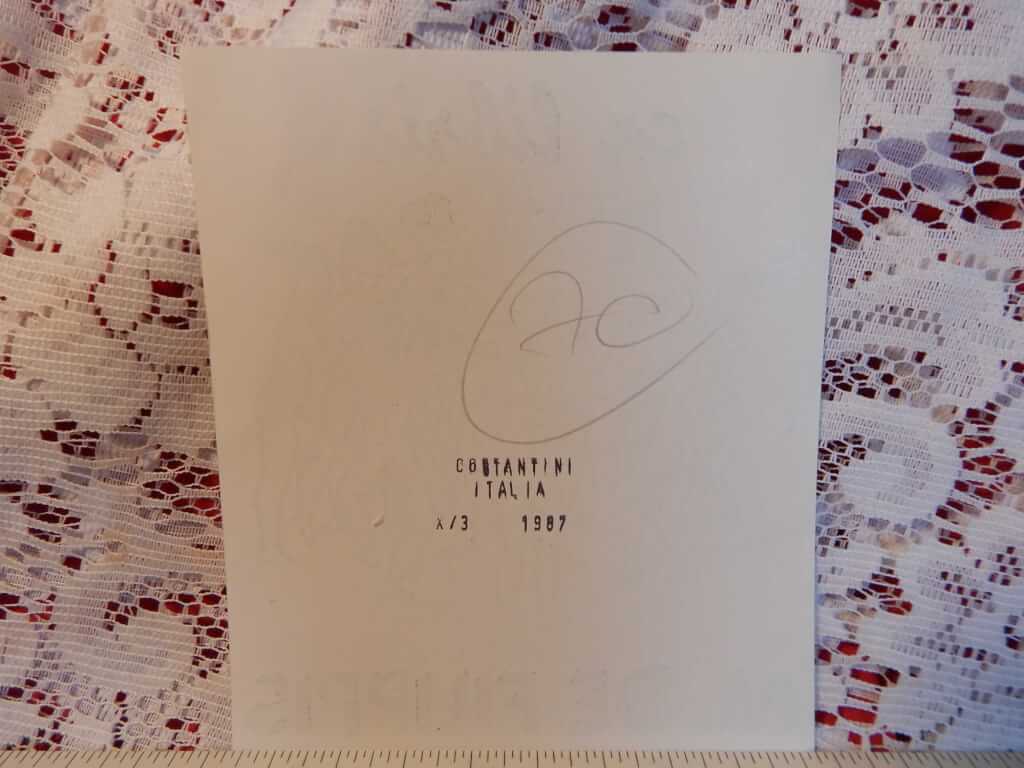
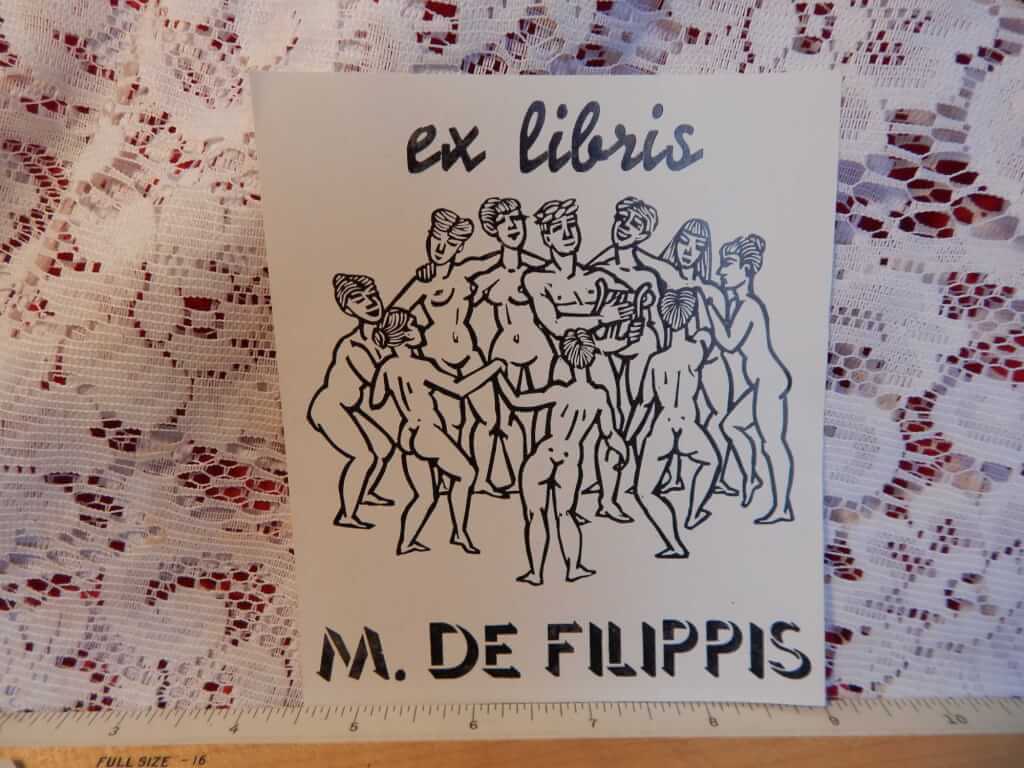 Ex Libris M. De Filippis by Constante Constantini 4.5 x 5.25", purchased from a collection in Italy, "Constantini, Italia, x/3, 1987" stamped on back Naked man playing a harp while naked dancers encircle him. One of the most important (and largest) collections of ex libris in the world belongs to Mario De Filippis, the owner of Buca di San Francesco restaurant in Arezzo Italy. He has over 130,000 ex libris in his collection, approximately 13,000 are personal ex libris plates he's commissioned from artists all over the world using a multitude of printing techniques. His website describes Mario as "a passionate lover of small graphics".
Ex Libris M. De Filippis by Constante Constantini 4.5 x 5.25", purchased from a collection in Italy, "Constantini, Italia, x/3, 1987" stamped on back Naked man playing a harp while naked dancers encircle him. One of the most important (and largest) collections of ex libris in the world belongs to Mario De Filippis, the owner of Buca di San Francesco restaurant in Arezzo Italy. He has over 130,000 ex libris in his collection, approximately 13,000 are personal ex libris plates he's commissioned from artists all over the world using a multitude of printing techniques. His website describes Mario as "a passionate lover of small graphics". -
Out of stock
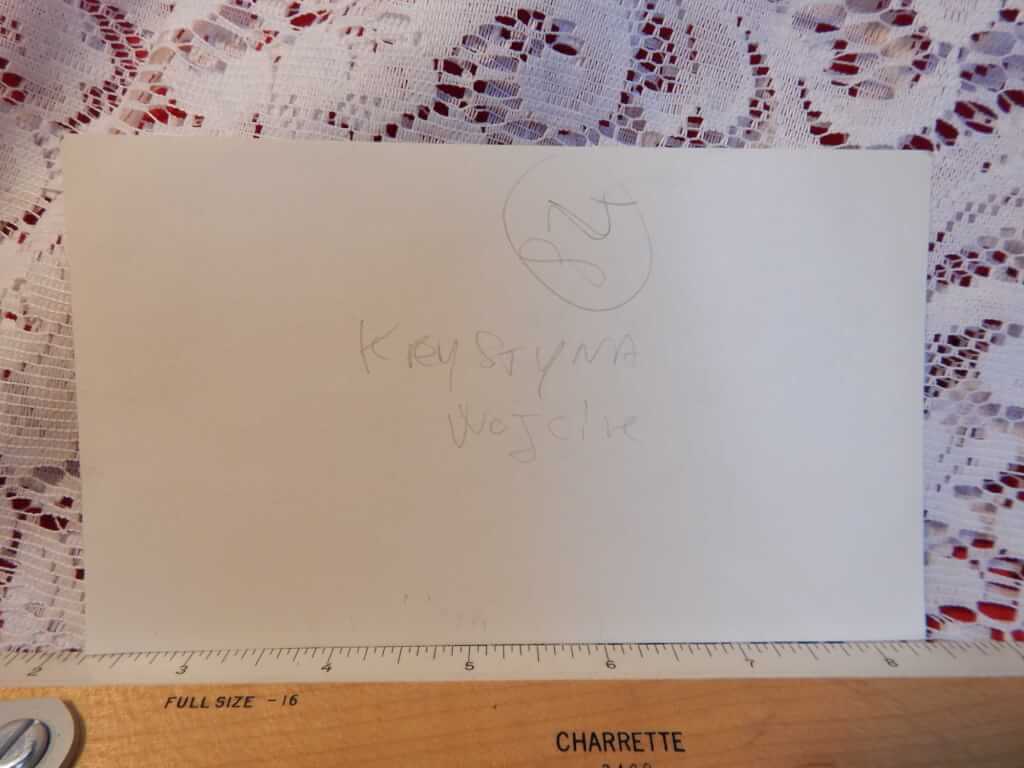
 Ex Libris Dr. Dzurilikowsky by Krystyna Wojcik purchased from a collection in Italy, "Krystyna Wojcik" written in pencil on back Naked woman's torso combined with an orchid
Ex Libris Dr. Dzurilikowsky by Krystyna Wojcik purchased from a collection in Italy, "Krystyna Wojcik" written in pencil on back Naked woman's torso combined with an orchid -
Out of stock
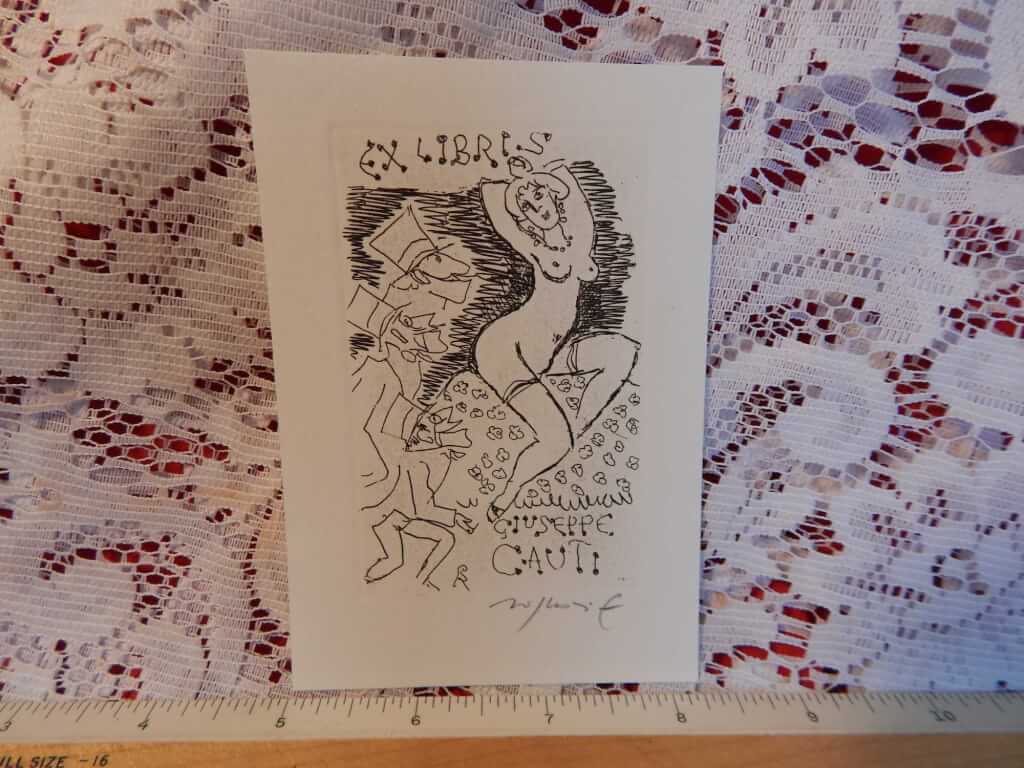 Ex Libris Giuseppe Cauti, by Franco Rognoni purchased from a collection in Italy. Naked woman being admired by men in top hats. Franco Rognoni (1913-1999) was an Italian artist and illustrator
Ex Libris Giuseppe Cauti, by Franco Rognoni purchased from a collection in Italy. Naked woman being admired by men in top hats. Franco Rognoni (1913-1999) was an Italian artist and illustrator -
 D'Accord Ex Libris Erny Camen, by Franz von Bayros paper size 4.75 x 6.25", print size 3.25 x 4.5" topless woman and two children lounging on a long line of erect penises, unknown signature in lower right corner not seen in other copies Franz von Bayros (1866 – 1924) was an Austrian commercial artist, illustrator, and painter, now he is best known for his erotic work. He belonged to the Decadent movement in art, often utilizing erotic themes and phantasmagoric imagery. At the age 17, Bayros passed the entrance exam for the Vienna Academy with Eduard von Engerth. Bayros mixed in elegant society and soon belonged to the circle of friends of Johann Straub, whose step daughter Alice he married on 1896. The next year, Bayros moved to Munich. In 1904, Bayros gave his first exhibition in Munich, which was a great success. From 1904 until 1908, Bayros traveled to Paris and Italy for his studies. Typically, for an artist dealing with such imagery, von Bayros produced work under several pseudonyms, most notably Choisy Le Conin, and was hounded by authorities for much of his life for his “indecent” art often very imaginative, and including such taboo subjects as sadomasochism and bestiality. He became equally well-known for his masterly drawn figures of elegant modestly nude and non-nude women.
D'Accord Ex Libris Erny Camen, by Franz von Bayros paper size 4.75 x 6.25", print size 3.25 x 4.5" topless woman and two children lounging on a long line of erect penises, unknown signature in lower right corner not seen in other copies Franz von Bayros (1866 – 1924) was an Austrian commercial artist, illustrator, and painter, now he is best known for his erotic work. He belonged to the Decadent movement in art, often utilizing erotic themes and phantasmagoric imagery. At the age 17, Bayros passed the entrance exam for the Vienna Academy with Eduard von Engerth. Bayros mixed in elegant society and soon belonged to the circle of friends of Johann Straub, whose step daughter Alice he married on 1896. The next year, Bayros moved to Munich. In 1904, Bayros gave his first exhibition in Munich, which was a great success. From 1904 until 1908, Bayros traveled to Paris and Italy for his studies. Typically, for an artist dealing with such imagery, von Bayros produced work under several pseudonyms, most notably Choisy Le Conin, and was hounded by authorities for much of his life for his “indecent” art often very imaginative, and including such taboo subjects as sadomasochism and bestiality. He became equally well-known for his masterly drawn figures of elegant modestly nude and non-nude women. -
Out of stock
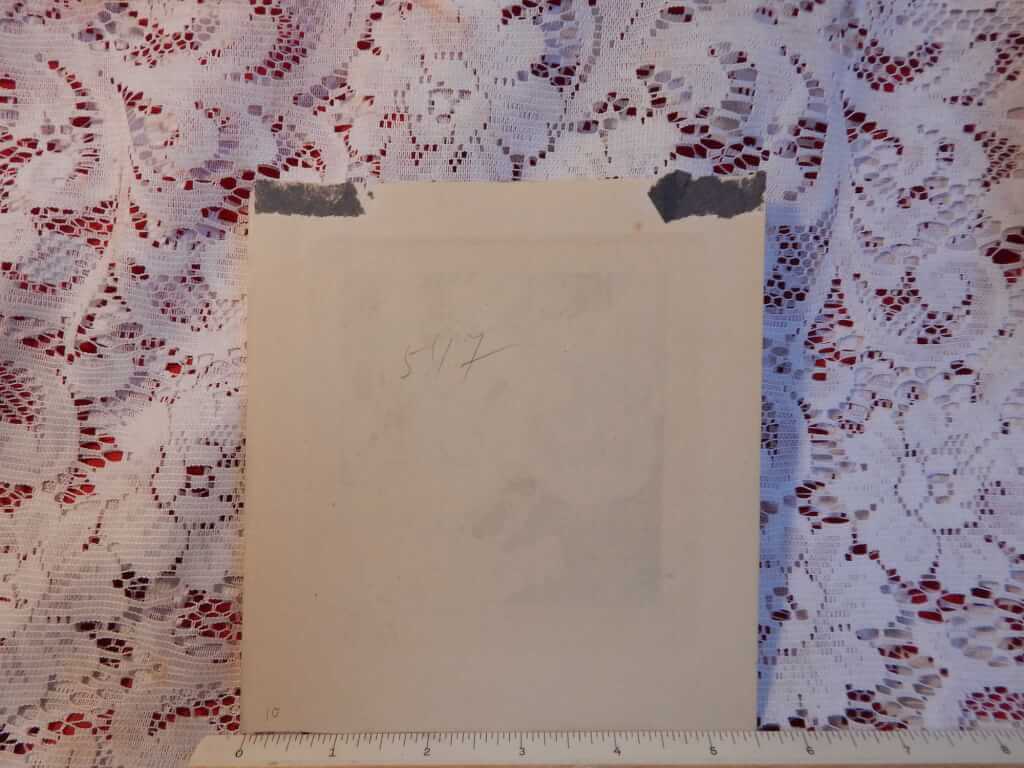
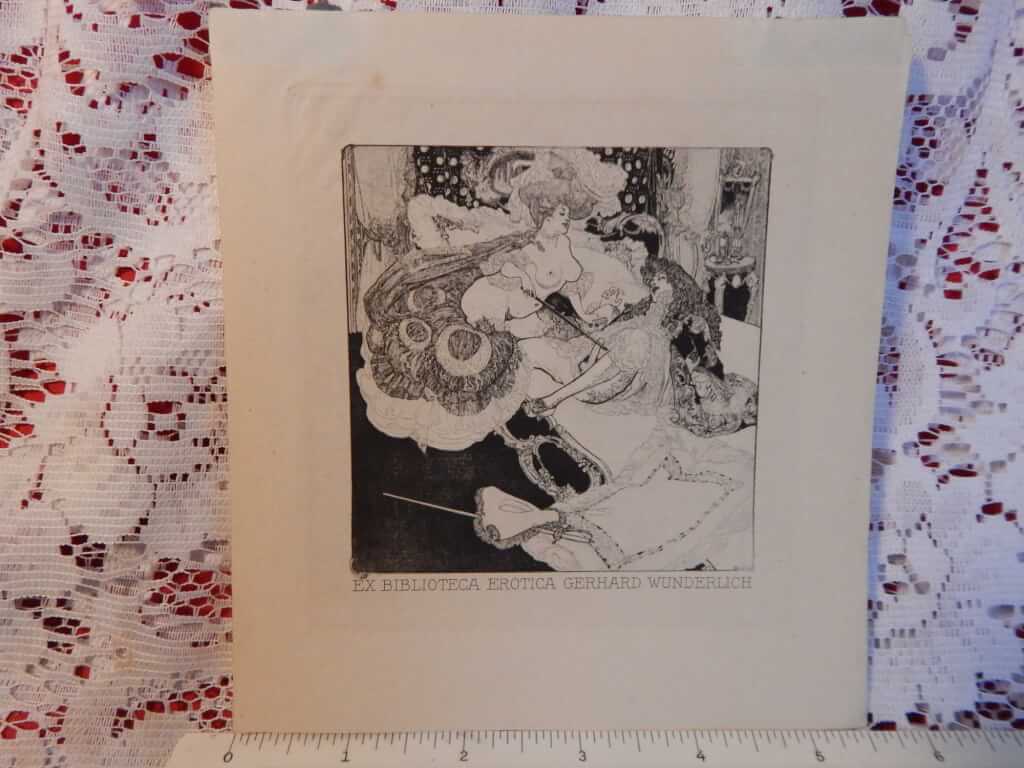 Ex Biblioteca Erotica Gerhard Wunderlich, by Franz von Bayros naked woman with cane, holding it against erect penis, remnants of pastedown at top of back Franz von Bayros (1866 – 1924) was an Austrian commercial artist, illustrator, and painter, now he is best known for his erotic work. He belonged to the Decadent movement in art, often utilizing erotic themes and phantasmagoric imagery. At the age 17, Bayros passed the entrance exam for the Vienna Academy with Eduard von Engerth. Bayros mixed in elegant society and soon belonged to the circle of friends of Johann Straub, whose step daughter Alice he married on 1896. The next year, Bayros moved to Munich. In 1904, Bayros gave his first exhibition in Munich, which was a great success. From 1904 until 1908, Bayros traveled to Paris and Italy for his studies. Typically, for an artist dealing with such imagery, von Bayros produced work under several pseudonyms, most notably Choisy Le Conin, and was hounded by authorities for much of his life for his “indecent” art often very imaginative, and including such taboo subjects as sadomasochism and bestiality. He became equally well-known for his masterly drawn figures of elegant modestly nude and non-nude women.
Ex Biblioteca Erotica Gerhard Wunderlich, by Franz von Bayros naked woman with cane, holding it against erect penis, remnants of pastedown at top of back Franz von Bayros (1866 – 1924) was an Austrian commercial artist, illustrator, and painter, now he is best known for his erotic work. He belonged to the Decadent movement in art, often utilizing erotic themes and phantasmagoric imagery. At the age 17, Bayros passed the entrance exam for the Vienna Academy with Eduard von Engerth. Bayros mixed in elegant society and soon belonged to the circle of friends of Johann Straub, whose step daughter Alice he married on 1896. The next year, Bayros moved to Munich. In 1904, Bayros gave his first exhibition in Munich, which was a great success. From 1904 until 1908, Bayros traveled to Paris and Italy for his studies. Typically, for an artist dealing with such imagery, von Bayros produced work under several pseudonyms, most notably Choisy Le Conin, and was hounded by authorities for much of his life for his “indecent” art often very imaginative, and including such taboo subjects as sadomasochism and bestiality. He became equally well-known for his masterly drawn figures of elegant modestly nude and non-nude women. -
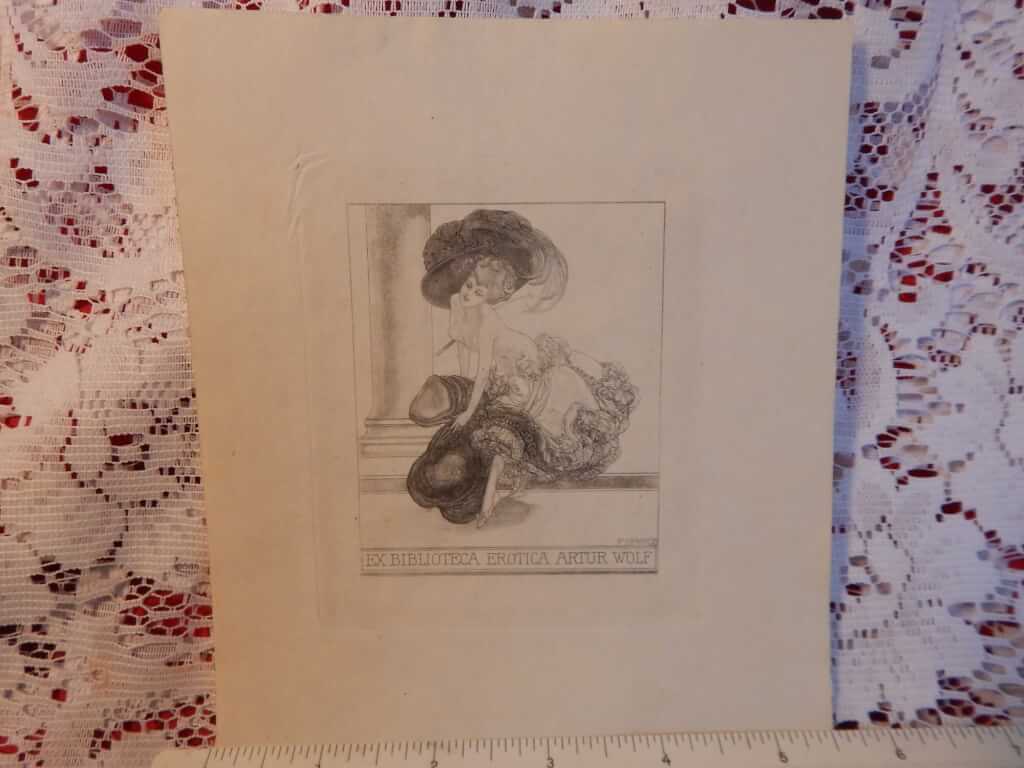 Ex Biblioteca Erotica Artur Wolf, by Franz von Bayros paper size 5.5 x 6.25", print size 3.5 x 4" topless women with large hat and a crop under her right arm, walking(?) a large penis Franz von Bayros (1866 – 1924) was an Austrian commercial artist, illustrator, and painter, now he is best known for his erotic work. He belonged to the Decadent movement in art, often utilizing erotic themes and phantasmagoric imagery. At the age 17, Bayros passed the entrance exam for the Vienna Academy with Eduard von Engerth. Bayros mixed in elegant society and soon belonged to the circle of friends of Johann Straub, whose step daughter Alice he married on 1896. The next year, Bayros moved to Munich. In 1904, Bayros gave his first exhibition in Munich, which was a great success. From 1904 until 1908, Bayros traveled to Paris and Italy for his studies. Typically, for an artist dealing with such imagery, von Bayros produced work under several pseudonyms, most notably Choisy Le Conin, and was hounded by authorities for much of his life for his “indecent” art often very imaginative, and including such taboo subjects as sadomasochism and bestiality. He became equally well-known for his masterly drawn figures of elegant modestly nude and non-nude women.
Ex Biblioteca Erotica Artur Wolf, by Franz von Bayros paper size 5.5 x 6.25", print size 3.5 x 4" topless women with large hat and a crop under her right arm, walking(?) a large penis Franz von Bayros (1866 – 1924) was an Austrian commercial artist, illustrator, and painter, now he is best known for his erotic work. He belonged to the Decadent movement in art, often utilizing erotic themes and phantasmagoric imagery. At the age 17, Bayros passed the entrance exam for the Vienna Academy with Eduard von Engerth. Bayros mixed in elegant society and soon belonged to the circle of friends of Johann Straub, whose step daughter Alice he married on 1896. The next year, Bayros moved to Munich. In 1904, Bayros gave his first exhibition in Munich, which was a great success. From 1904 until 1908, Bayros traveled to Paris and Italy for his studies. Typically, for an artist dealing with such imagery, von Bayros produced work under several pseudonyms, most notably Choisy Le Conin, and was hounded by authorities for much of his life for his “indecent” art often very imaginative, and including such taboo subjects as sadomasochism and bestiality. He became equally well-known for his masterly drawn figures of elegant modestly nude and non-nude women. -
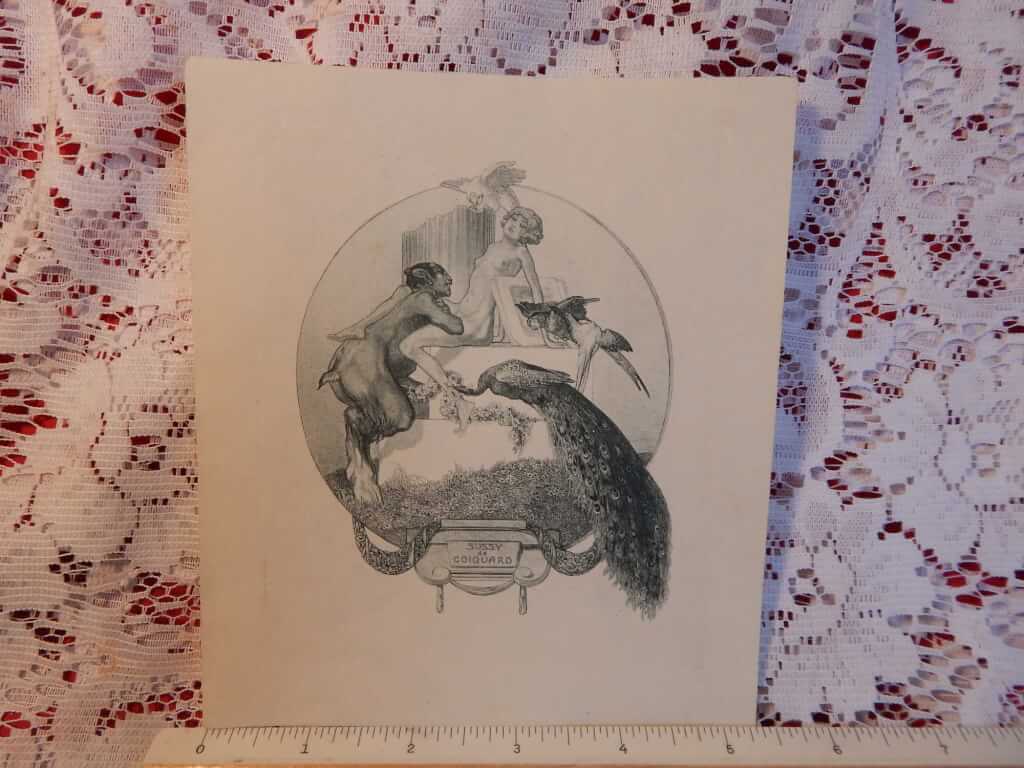 Ex libris Sussy de Coiquard, by Franz von Bayros paper size 5.5 x 6.25", print size 4.25 x 5.25" naked girl entertaining Pan(?), with peacock and other birds Franz von Bayros (1866 – 1924) was an Austrian commercial artist, illustrator, and painter, now he is best known for his erotic work. He belonged to the Decadent movement in art, often utilizing erotic themes and phantasmagoric imagery. At the age 17, Bayros passed the entrance exam for the Vienna Academy with Eduard von Engerth. Bayros mixed in elegant society and soon belonged to the circle of friends of Johann Straub, whose step daughter Alice he married on 1896. The next year, Bayros moved to Munich. In 1904, Bayros gave his first exhibition in Munich, which was a great success. From 1904 until 1908, Bayros traveled to Paris and Italy for his studies. Typically, for an artist dealing with such imagery, von Bayros produced work under several pseudonyms, most notably Choisy Le Conin, and was hounded by authorities for much of his life for his “indecent” art often very imaginative, and including such taboo subjects as sadomasochism and bestiality. He became equally well-known for his masterly drawn figures of elegant modestly nude and non-nude women.
Ex libris Sussy de Coiquard, by Franz von Bayros paper size 5.5 x 6.25", print size 4.25 x 5.25" naked girl entertaining Pan(?), with peacock and other birds Franz von Bayros (1866 – 1924) was an Austrian commercial artist, illustrator, and painter, now he is best known for his erotic work. He belonged to the Decadent movement in art, often utilizing erotic themes and phantasmagoric imagery. At the age 17, Bayros passed the entrance exam for the Vienna Academy with Eduard von Engerth. Bayros mixed in elegant society and soon belonged to the circle of friends of Johann Straub, whose step daughter Alice he married on 1896. The next year, Bayros moved to Munich. In 1904, Bayros gave his first exhibition in Munich, which was a great success. From 1904 until 1908, Bayros traveled to Paris and Italy for his studies. Typically, for an artist dealing with such imagery, von Bayros produced work under several pseudonyms, most notably Choisy Le Conin, and was hounded by authorities for much of his life for his “indecent” art often very imaginative, and including such taboo subjects as sadomasochism and bestiality. He became equally well-known for his masterly drawn figures of elegant modestly nude and non-nude women. -
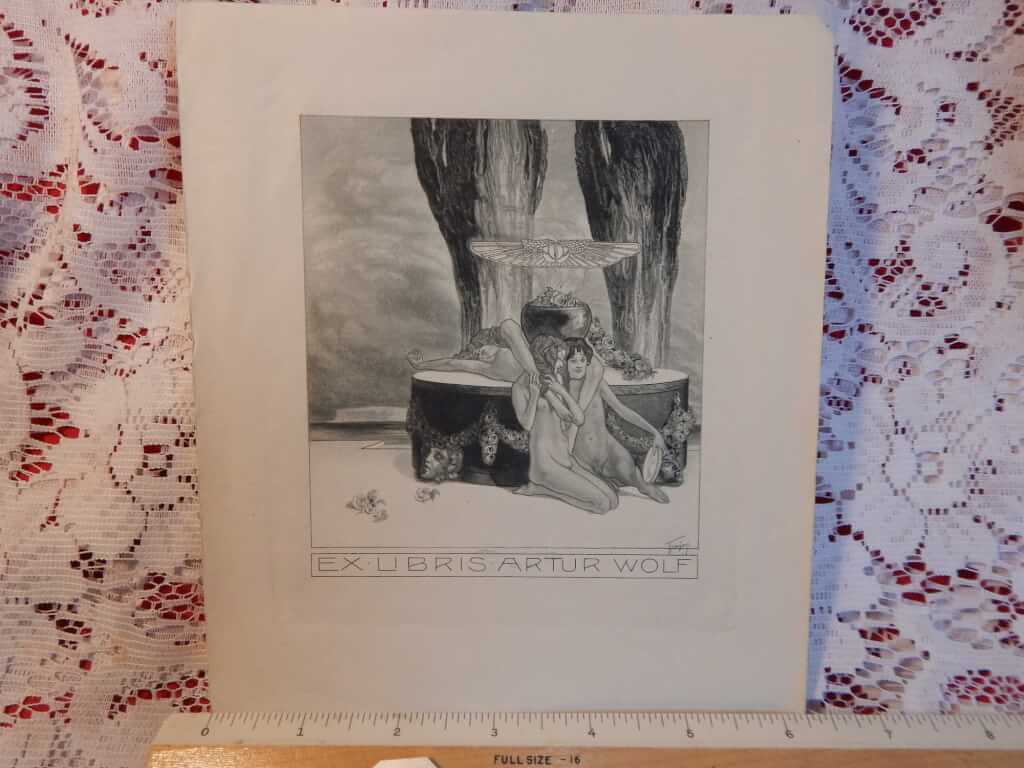 Ex Libris Artur Wolf, by Franz von Bayros paper size 6.25 x 7.25", print size 5 x 5.75", on hand laid paper three naked girls Franz von Bayros (1866 – 1924) was an Austrian commercial artist, illustrator, and painter, now he is best known for his erotic work. He belonged to the Decadent movement in art, often utilizing erotic themes and phantasmagoric imagery. At the age 17, Bayros passed the entrance exam for the Vienna Academy with Eduard von Engerth. Bayros mixed in elegant society and soon belonged to the circle of friends of Johann Straub, whose step daughter Alice he married on 1896. The next year, Bayros moved to Munich. In 1904, Bayros gave his first exhibition in Munich, which was a great success. From 1904 until 1908, Bayros traveled to Paris and Italy for his studies. Typically, for an artist dealing with such imagery, von Bayros produced work under several pseudonyms, most notably Choisy Le Conin, and was hounded by authorities for much of his life for his “indecent” art often very imaginative, and including such taboo subjects as sadomasochism and bestiality. He became equally well-known for his masterly drawn figures of elegant modestly nude and non-nude women.
Ex Libris Artur Wolf, by Franz von Bayros paper size 6.25 x 7.25", print size 5 x 5.75", on hand laid paper three naked girls Franz von Bayros (1866 – 1924) was an Austrian commercial artist, illustrator, and painter, now he is best known for his erotic work. He belonged to the Decadent movement in art, often utilizing erotic themes and phantasmagoric imagery. At the age 17, Bayros passed the entrance exam for the Vienna Academy with Eduard von Engerth. Bayros mixed in elegant society and soon belonged to the circle of friends of Johann Straub, whose step daughter Alice he married on 1896. The next year, Bayros moved to Munich. In 1904, Bayros gave his first exhibition in Munich, which was a great success. From 1904 until 1908, Bayros traveled to Paris and Italy for his studies. Typically, for an artist dealing with such imagery, von Bayros produced work under several pseudonyms, most notably Choisy Le Conin, and was hounded by authorities for much of his life for his “indecent” art often very imaginative, and including such taboo subjects as sadomasochism and bestiality. He became equally well-known for his masterly drawn figures of elegant modestly nude and non-nude women. -
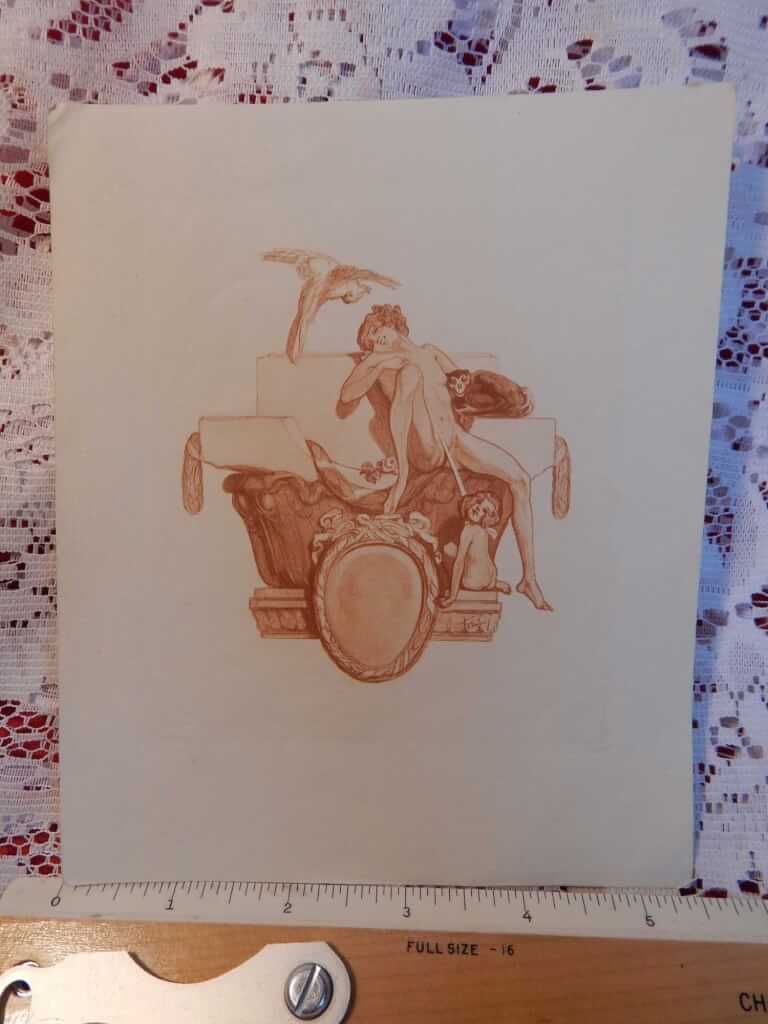 bookplate, by Franz von Bayros paper size 5.5 x 6.5", print size 4 x 4.5", on hand laid paper naked girl, animals, and child Franz von Bayros (1866 – 1924) was an Austrian commercial artist, illustrator, and painter, now he is best known for his erotic work. He belonged to the Decadent movement in art, often utilizing erotic themes and phantasmagoric imagery. At the age 17, Bayros passed the entrance exam for the Vienna Academy with Eduard von Engerth. Bayros mixed in elegant society and soon belonged to the circle of friends of Johann Straub, whose step daughter Alice he married on 1896. The next year, Bayros moved to Munich. In 1904, Bayros gave his first exhibition in Munich, which was a great success. From 1904 until 1908, Bayros traveled to Paris and Italy for his studies. Typically, for an artist dealing with such imagery, von Bayros produced work under several pseudonyms, most notably Choisy Le Conin, and was hounded by authorities for much of his life for his “indecent” art often very imaginative, and including such taboo subjects as sadomasochism and bestiality. He became equally well-known for his masterly drawn figures of elegant modestly nude and non-nude women.
bookplate, by Franz von Bayros paper size 5.5 x 6.5", print size 4 x 4.5", on hand laid paper naked girl, animals, and child Franz von Bayros (1866 – 1924) was an Austrian commercial artist, illustrator, and painter, now he is best known for his erotic work. He belonged to the Decadent movement in art, often utilizing erotic themes and phantasmagoric imagery. At the age 17, Bayros passed the entrance exam for the Vienna Academy with Eduard von Engerth. Bayros mixed in elegant society and soon belonged to the circle of friends of Johann Straub, whose step daughter Alice he married on 1896. The next year, Bayros moved to Munich. In 1904, Bayros gave his first exhibition in Munich, which was a great success. From 1904 until 1908, Bayros traveled to Paris and Italy for his studies. Typically, for an artist dealing with such imagery, von Bayros produced work under several pseudonyms, most notably Choisy Le Conin, and was hounded by authorities for much of his life for his “indecent” art often very imaginative, and including such taboo subjects as sadomasochism and bestiality. He became equally well-known for his masterly drawn figures of elegant modestly nude and non-nude women. -
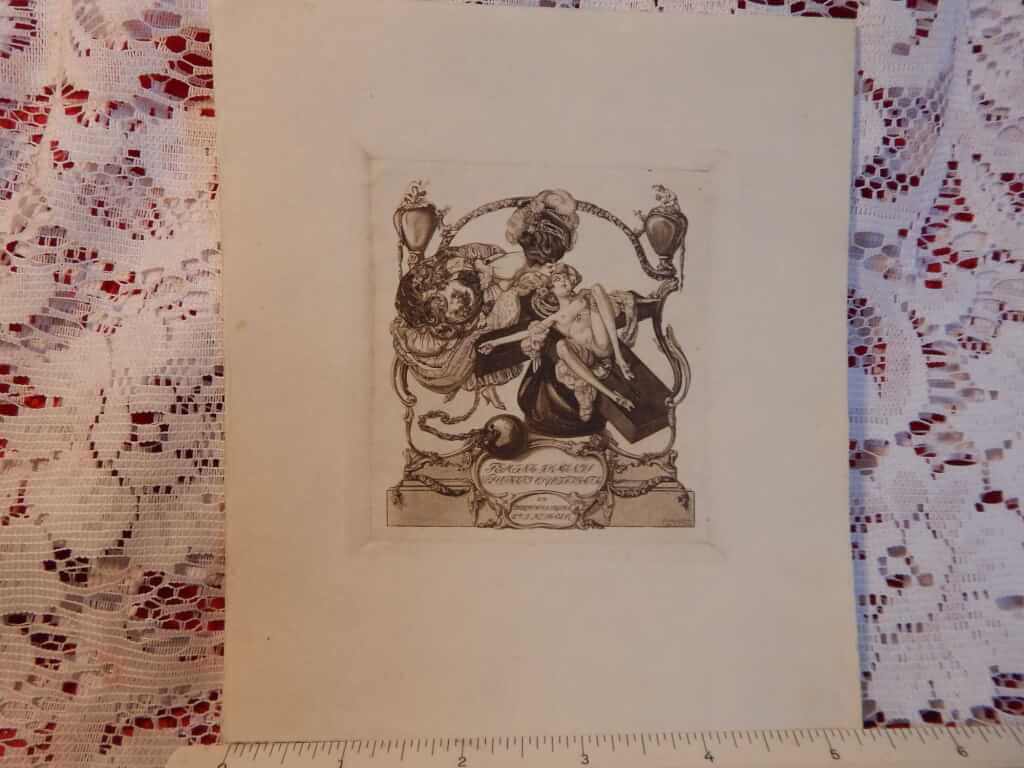 Femina Hominis Voluptati Crucifigata, Ex Bibliotheca Erotica Dr. J. Klueber, by Franz von Bayros paper size 5.5 x 6.25", print size 3.5 x 3.5" Topless handcuffed woman consoling naked girl nailed to cross. "Femina Hominis Voluptati Crucifigata" is possibly latin for "the woman is man's pleasure crucified"? The detail in this print is magnifying-glass-worthy as there are copulating couples at the top of the columns. Franz von Bayros (1866 – 1924) was an Austrian commercial artist, illustrator, and painter, now he is best known for his erotic work. He belonged to the Decadent movement in art, often utilizing erotic themes and phantasmagoric imagery. At the age 17, Bayros passed the entrance exam for the Vienna Academy with Eduard von Engerth. Bayros mixed in elegant society and soon belonged to the circle of friends of Johann Straub, whose step daughter Alice he married on 1896. The next year, Bayros moved to Munich. In 1904, Bayros gave his first exhibition in Munich, which was a great success. From 1904 until 1908, Bayros traveled to Paris and Italy for his studies. Typically, for an artist dealing with such imagery, von Bayros produced work under several pseudonyms, most notably Choisy Le Conin, and was hounded by authorities for much of his life for his “indecent” art often very imaginative, and including such taboo subjects as sadomasochism and bestiality. He became equally well-known for his masterly drawn figures of elegant modestly nude and non-nude women.
Femina Hominis Voluptati Crucifigata, Ex Bibliotheca Erotica Dr. J. Klueber, by Franz von Bayros paper size 5.5 x 6.25", print size 3.5 x 3.5" Topless handcuffed woman consoling naked girl nailed to cross. "Femina Hominis Voluptati Crucifigata" is possibly latin for "the woman is man's pleasure crucified"? The detail in this print is magnifying-glass-worthy as there are copulating couples at the top of the columns. Franz von Bayros (1866 – 1924) was an Austrian commercial artist, illustrator, and painter, now he is best known for his erotic work. He belonged to the Decadent movement in art, often utilizing erotic themes and phantasmagoric imagery. At the age 17, Bayros passed the entrance exam for the Vienna Academy with Eduard von Engerth. Bayros mixed in elegant society and soon belonged to the circle of friends of Johann Straub, whose step daughter Alice he married on 1896. The next year, Bayros moved to Munich. In 1904, Bayros gave his first exhibition in Munich, which was a great success. From 1904 until 1908, Bayros traveled to Paris and Italy for his studies. Typically, for an artist dealing with such imagery, von Bayros produced work under several pseudonyms, most notably Choisy Le Conin, and was hounded by authorities for much of his life for his “indecent” art often very imaginative, and including such taboo subjects as sadomasochism and bestiality. He became equally well-known for his masterly drawn figures of elegant modestly nude and non-nude women. -
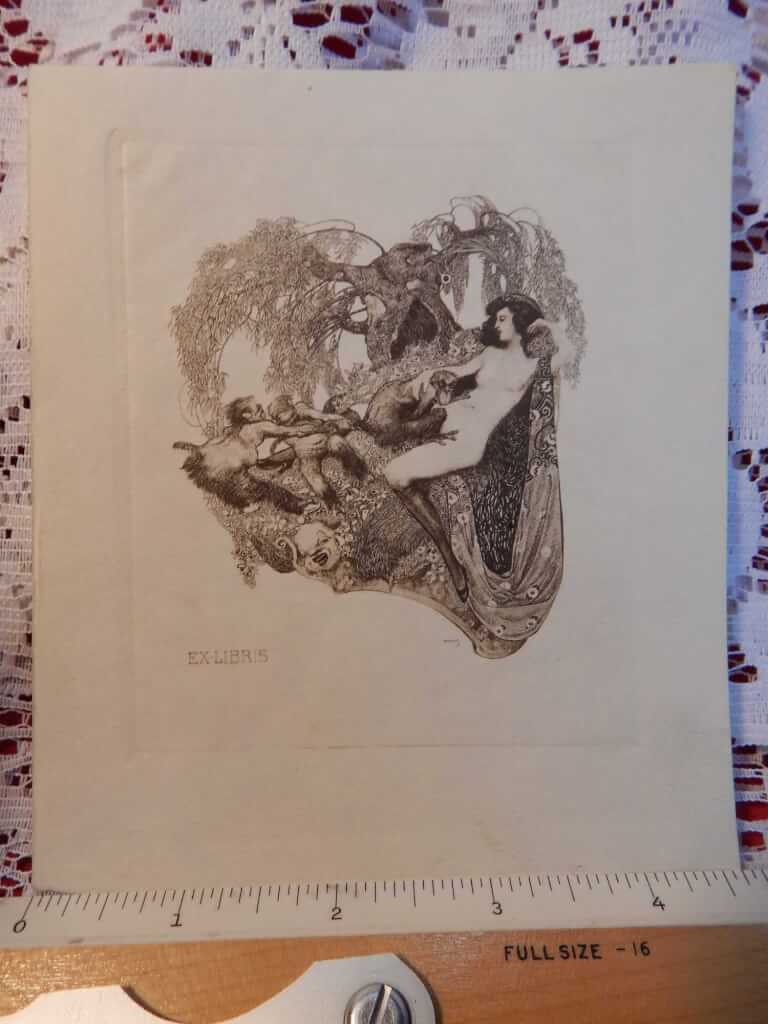 Ex Libris, by Franz von Bayros paper size 4.75 x 5.5", print size 3.5 x 4" naked woman sitting in a tree being "intimate" with monkey, other monkeys trying to pull him away from her. Very detailed and ornate. Franz von Bayros (1866 – 1924) was an Austrian commercial artist, illustrator, and painter, now he is best known for his erotic work. He belonged to the Decadent movement in art, often utilizing erotic themes and phantasmagoric imagery. At the age 17, Bayros passed the entrance exam for the Vienna Academy with Eduard von Engerth. Bayros mixed in elegant society and soon belonged to the circle of friends of Johann Straub, whose step daughter Alice he married on 1896. The next year, Bayros moved to Munich. In 1904, Bayros gave his first exhibition in Munich, which was a great success. From 1904 until 1908, Bayros traveled to Paris and Italy for his studies. Typically, for an artist dealing with such imagery, von Bayros produced work under several pseudonyms, most notably Choisy Le Conin, and was hounded by authorities for much of his life for his “indecent” art often very imaginative, and including such taboo subjects as sadomasochism and bestiality. He became equally well-known for his masterly drawn figures of elegant modestly nude and non-nude women.
Ex Libris, by Franz von Bayros paper size 4.75 x 5.5", print size 3.5 x 4" naked woman sitting in a tree being "intimate" with monkey, other monkeys trying to pull him away from her. Very detailed and ornate. Franz von Bayros (1866 – 1924) was an Austrian commercial artist, illustrator, and painter, now he is best known for his erotic work. He belonged to the Decadent movement in art, often utilizing erotic themes and phantasmagoric imagery. At the age 17, Bayros passed the entrance exam for the Vienna Academy with Eduard von Engerth. Bayros mixed in elegant society and soon belonged to the circle of friends of Johann Straub, whose step daughter Alice he married on 1896. The next year, Bayros moved to Munich. In 1904, Bayros gave his first exhibition in Munich, which was a great success. From 1904 until 1908, Bayros traveled to Paris and Italy for his studies. Typically, for an artist dealing with such imagery, von Bayros produced work under several pseudonyms, most notably Choisy Le Conin, and was hounded by authorities for much of his life for his “indecent” art often very imaginative, and including such taboo subjects as sadomasochism and bestiality. He became equally well-known for his masterly drawn figures of elegant modestly nude and non-nude women. -
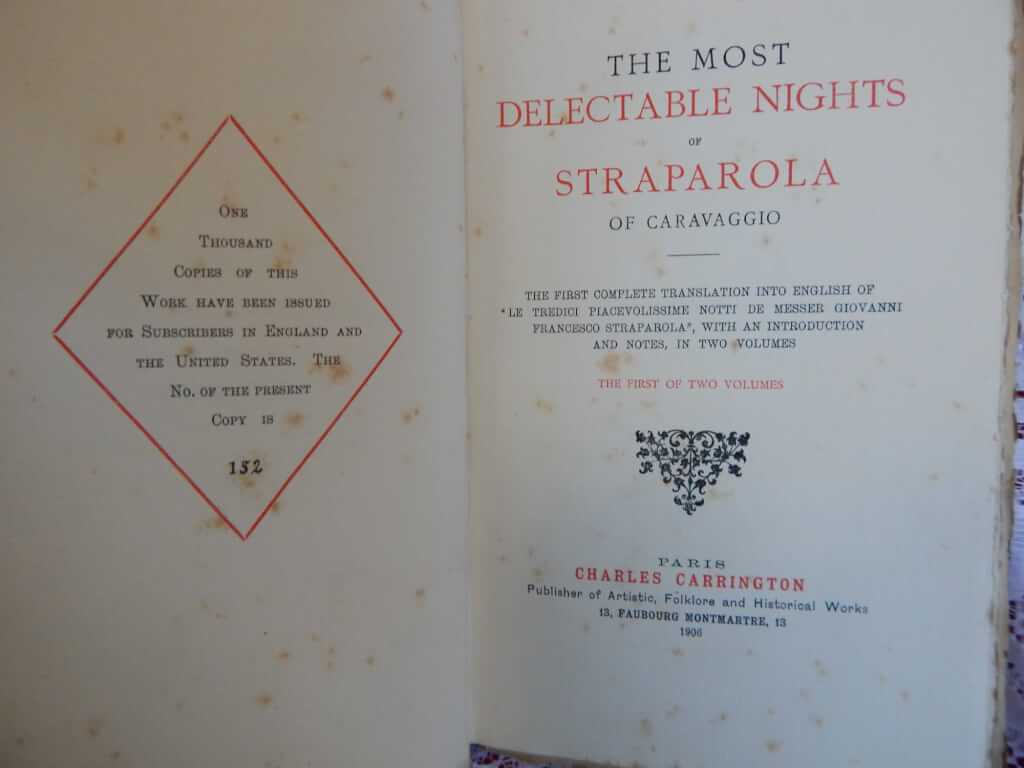
 The Most Delectable Nights of Straparola of Caravaggio, the first complete translation into english of "Le tredici piacevolissime notte, de Mesier Giovanni Francesco Straparola", with an introduction and notes, in two volumes, illust. by Léon Lebègue and Adolph Lambrecht (Charles Carrington, "Publisher of Artistic, Folklore and Historical Works", Paris, 1906, #152/1000, [first english translation, first edition] "Printed in Holland at the Printing Works of G. J. Thieme, Nymeguen.") 5.75"x8.5", 2 vol. xvi+352pp, xl+420pp, top edge gilt other edges deckled, blue boards with gilt borders and gilt lettering to the spines, red and black text and decorations throughout, numerous illustrations, both vignettes within text and tipped-in full color plates with descriptive tissue guards, handsome good+ copy for age, some foxing, small tear at top of vol. 1 spine, slight sunning to boards. This is a rare, beautifully executed, 1st edition, 1st English translation, 1st printing, low number limited edition, by Charles Carrington. Giovanni Francesco "Gianfrancesco" Straparola, also known as Zoan or Zuan Francesco Straparola da Caravaggio (1485?-1558) was a writer of poetry, and collector and writer of short stories. Some time during his life, he migrated from Caravaggio to Venice where he published a collection of stories in two volumes called Le piacevoli notti (1551 and 1553) (The Pleasant Nights, first translated by W. G. Waters in 1901 as "The Facetious Nights"). The Pleasant Nights is the work for which Straparola is most noted, and which contains a total of seventy-five short stories, fables, and fairy tales. The tales, or novelle, are divided into Nights, rather than chapters, and resemble the type of narrative presentation found in Boccaccio's Decameron. This presentation is of a gathering of Italian aristocrats, men and women, who entertain themselves by singing songs, dancing, telling stories and presenting enigmas (riddles). The Pleasant Nights contains many different types of tales, including realistic novellas, stories about practical jokes, tragic and triumphant love stories, bawdy tales, and animal stories. Some sixteen of these 74 tales are fairy tales including the story of Puss-in-Boots, the story of an impoverished boy whose enchanted cat earns him wealth, marriage to a princess, and a kingdom. Among the other fairy tales in The Pleasant Nights, we find a dragon slayer tale; the tale of a prince born in the shape of a pig due to a fairy’s curse who regains his human form only after marrying three time,; the story of Biancabella or “White Beauty” a princes who undergoes many trials until finally being saved by a fairy; and the a poor girl who acquire a magic doll that poops money and helps her marry a prince. It is claimed that many of the stories within The Pleasant Nights had been taken from earlier works, specifically from Girolamo Morlini, a 15th/16th century lawyer from Naples. If taken at his word, Straparola never denied this. In the Dedication at the front of the second volume, Straparola wrote that the stories ". . . written and collected in this volume [vol. 2 only?] are none of mine, but goods which I have feloniously taken from this man and that. Of a truth I confess they are not mine, and if I said otherwise I should lie, but nevertheless I have faithfully set them down according to the manner in which they were told by the ladies, nobles, learned men and gentlemen who gathered together for recreation."
The Most Delectable Nights of Straparola of Caravaggio, the first complete translation into english of "Le tredici piacevolissime notte, de Mesier Giovanni Francesco Straparola", with an introduction and notes, in two volumes, illust. by Léon Lebègue and Adolph Lambrecht (Charles Carrington, "Publisher of Artistic, Folklore and Historical Works", Paris, 1906, #152/1000, [first english translation, first edition] "Printed in Holland at the Printing Works of G. J. Thieme, Nymeguen.") 5.75"x8.5", 2 vol. xvi+352pp, xl+420pp, top edge gilt other edges deckled, blue boards with gilt borders and gilt lettering to the spines, red and black text and decorations throughout, numerous illustrations, both vignettes within text and tipped-in full color plates with descriptive tissue guards, handsome good+ copy for age, some foxing, small tear at top of vol. 1 spine, slight sunning to boards. This is a rare, beautifully executed, 1st edition, 1st English translation, 1st printing, low number limited edition, by Charles Carrington. Giovanni Francesco "Gianfrancesco" Straparola, also known as Zoan or Zuan Francesco Straparola da Caravaggio (1485?-1558) was a writer of poetry, and collector and writer of short stories. Some time during his life, he migrated from Caravaggio to Venice where he published a collection of stories in two volumes called Le piacevoli notti (1551 and 1553) (The Pleasant Nights, first translated by W. G. Waters in 1901 as "The Facetious Nights"). The Pleasant Nights is the work for which Straparola is most noted, and which contains a total of seventy-five short stories, fables, and fairy tales. The tales, or novelle, are divided into Nights, rather than chapters, and resemble the type of narrative presentation found in Boccaccio's Decameron. This presentation is of a gathering of Italian aristocrats, men and women, who entertain themselves by singing songs, dancing, telling stories and presenting enigmas (riddles). The Pleasant Nights contains many different types of tales, including realistic novellas, stories about practical jokes, tragic and triumphant love stories, bawdy tales, and animal stories. Some sixteen of these 74 tales are fairy tales including the story of Puss-in-Boots, the story of an impoverished boy whose enchanted cat earns him wealth, marriage to a princess, and a kingdom. Among the other fairy tales in The Pleasant Nights, we find a dragon slayer tale; the tale of a prince born in the shape of a pig due to a fairy’s curse who regains his human form only after marrying three time,; the story of Biancabella or “White Beauty” a princes who undergoes many trials until finally being saved by a fairy; and the a poor girl who acquire a magic doll that poops money and helps her marry a prince. It is claimed that many of the stories within The Pleasant Nights had been taken from earlier works, specifically from Girolamo Morlini, a 15th/16th century lawyer from Naples. If taken at his word, Straparola never denied this. In the Dedication at the front of the second volume, Straparola wrote that the stories ". . . written and collected in this volume [vol. 2 only?] are none of mine, but goods which I have feloniously taken from this man and that. Of a truth I confess they are not mine, and if I said otherwise I should lie, but nevertheless I have faithfully set them down according to the manner in which they were told by the ladies, nobles, learned men and gentlemen who gathered together for recreation."













